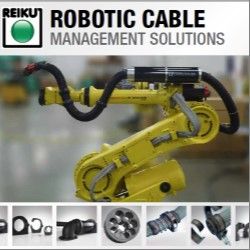“Robotics-as-a-service” is a model in which customers purchase automation on an “as-needed” basis. This could be monthly pricing or usage-based pricing. Upfront costs are typically negligible or non-existent.
 Why is Robotics-as-a-Service So Important Now
Why is Robotics-as-a-Service So Important Now

Q&A with Saman Farid & Misa Ilkhechi, Co-Founders | Formic
What is Formic, and who are the co-founders?
Formic is a robotics-as-a-service company that is fundamentally changing the way industrial robotics are scoped and deployed. We handle all of the logistics of an automation deployment, from scoping and customization to installation and maintenance. We don’t charge any money upfront, only a low hourly rate, which is typically 42% less than what companies pay for the same tasks to be executed with manual labor. You can think of it like hiring a robot.
We serve a variety of industries, but in particular, we focus on food and beverage, consumer packaged goods, automotive, plastics, packaging, and metal fabrication companies. Our robots can accomplish a broad range of tasks, including machine tending, material handling, inspection, welding, palletizing carton erecting, and more, and we work with all of the leading OEMs, including FANUC, UR, ABB, and Kuka.
We are Saman Farid and Misa Ilkhechi, and we are the co-founders of Formic. Saman’s background is in robotics, entrepreneurship, and venture capital. Misa’s background is in sales and engineering of robotics equipment. We wanted to come together to solve one of the biggest challenges in robotics: the question of access.
How does the Formic model work?
We wanted our model to be incredibly simple, transparent, fast, and risk-free.
Here’s how it works:
-
We work with our clients to identify tasks with the highest automation ROI
-
We scope the application and find the best equipment for the job
-
We quote a low hourly rate for the system and establish clear output requirements for the system
-
We then handle all installation, maintenance, repurposing, and upgrades of that system for the duration of the customer’s contract with us
What is robotics-as-a-service, and why is it important right now?
“Robotics-as-a-service” is a model in which customers purchase automation on an “as-needed” basis. This could be monthly pricing or usage-based pricing. Upfront costs are typically negligible or non-existent. Contract lengths are flexible, allowing business to take advantage of the system only for as long as they need it. The provider assumes the responsibility for servicing and upgrades throughout the duration of the contract.
The advantages of this model are greater flexibility, instant scalability, no risk, and total predictability on bottom-line operational expenses. Perhaps most importantly, RaaS can save you money from day one, unlike big capital projects, that could take years to become ROI positive.
The RaaS model is incredibly important right now, as manufacturers are scrambling to automate key processes due to an unprecedented labor shortage, rising wages, and an increase in global competition. For many manufacturers, automation is no longer a “nice to have,” it’s a “need to have.”
Automation will be a huge piece of American re-shoring efforts, but in order for that to happen for all segments of the manufacturing market, we need to make the deployment process much easier and more flexible than it is today.
What challenges in the manufacturing industry is RaaS solving?
There are 5 core barriers to automating that we hear manufacturers cite time and time again:
-
Capital: manufacturers don’t have the money lying around for large capital expenditures
-
Time: manufacturers are simply too busy to manage the complex process of purchasing and deploying automation equipment
-
Expertise: no in-house expertise can lead manufacturers to avoid automating entirely
-
Uncertainty: it’s tough for manufacturers to justify purchasing automation equipment without multi-year clarity on what your production processes and needs will be
-
Risk: owning your own automation equipment brings risk of failure, ranging from unforeseen maintenance expenses, or worse yet, a robot that is useless due to a change in production processes.
The traditional way of purchasing and deploying automation works pretty well for large manufacturers, who have a ton of in-house expertise and capital at their disposal.
Smaller and mid-sized manufacturers typically face one or more of the above barriers to entry when they consider automating.
What makes a particular company a good fit for RaaS?
RaaS is a particularly good fit for companies that fit one or more of these characteristics: 
-
Struggling to hire and retain employees
-
Don’t have large stores of capital available for automation improvements (or, perhaps capital is available, but budgeting for large outlays is too lengthy a process)
-
Don’t have in-house robotics expertise
-
Pressed for time
-
Want to save money on OpEx
-
Lack complete certainty on what future production needs will be and want flexibility
-
Risk-averse and want total clarity and certainty with their bottom line
What broader implications does RaaS have for the robotics industry?
The implications of RaaS are enormous for the robotics industry. It’s clear that the market needs a more flexible alternative to buying equipment, particularly now, when manufacturing is facing a unique set of challenges. There are many cases in which purchasing automation equipment makes sense, and will continue to make sense, but there are just as many scenarios, particularly in small to mid-sized facilities, where the benefits of the RaaS model will outweigh the traditional model.
On a macro scale, the rise of RaaS will mean many more robots in American manufacturing facilities, and that’s a good thing. American manufacturing lags behind global peers with regards to automation, and this is something that we need to address to not only remain competitive, but bring manufacturing back stateside in a cost-competitive fashion.
Look into the future 5 – 10 years, where do you see the RaaS business model and how has Formic played a role in developing it?
The exciting part of RaaS is that it’s still a really new concept. We have so many conversations with manufacturers that have never heard of the concept, and are delighted to learn there’s a better way of accessing automation.
manufacturers that have never heard of the concept, and are delighted to learn there’s a better way of accessing automation.
As RaaS grows, we see Formic as a key nexus point between end-users, robotics companies, and system integrators. Our model solves inefficiencies in the current process for each of these players. We think that in 5-10 years RaaS will be just as common as using cloud services for computing. It will be significantly more efficient to use RaaS than to buy, service and maintain owned equipment.
We think that in 5-10 years, there will be a large group of companies offering RaaS, competing to deliver value to their customers.
The content & opinions in this article are the author’s and do not necessarily represent the views of RoboticsTomorrow
Comments (0)
This post does not have any comments. Be the first to leave a comment below.
Featured Product

